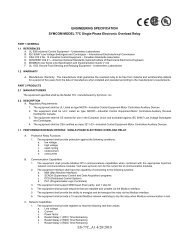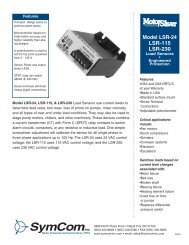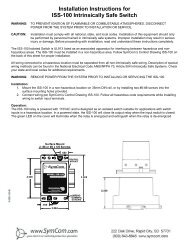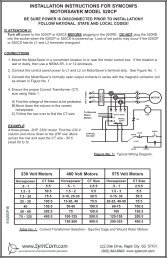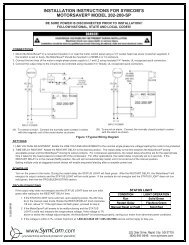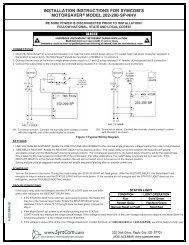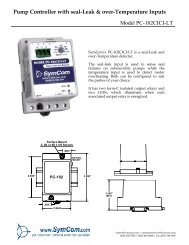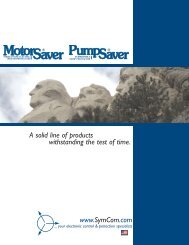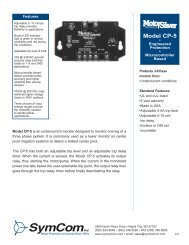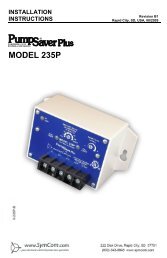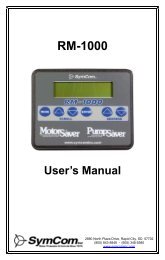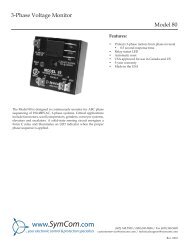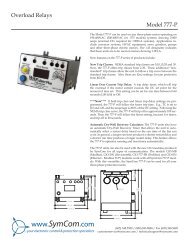connections installation instructions for symcom's model 777-hvr-sp ...
connections installation instructions for symcom's model 777-hvr-sp ...
connections installation instructions for symcom's model 777-hvr-sp ...
You also want an ePaper? Increase the reach of your titles
YUMPU automatically turns print PDFs into web optimized ePapers that Google loves.
OPERATIONOnce the overload relay has been programmed, turn the "MODE SELECT" switch to the "RUN" position.The LED di<strong>sp</strong>lay will flash "RUN" alternatively with a number representing the parameter indicated by the"DISPLAY / PROGRAM" adjustment. After the period of time programmed into RD1, the output contacts willclose and the value of the parameter indicated by the "DISPLAY / PROGRAM" adjustment will appear on theLED di<strong>sp</strong>lay.If a message other than those indicated above is shown on the LED di<strong>sp</strong>lay, see the TROUBLESHOOTINGsection on page 7 to diagnose the problem.SPECIFICATIONSOVERLOAD RELAYElectricalInput Voltage380 - 480 VAC, 1ØFrequency50-60 HzMotor Full Load Amp Range - 77C2-25 Amps, 3Ø(Loops Required)26-90 Amps, 3Ø(Direct)91-800 Amps, 3Ø(External CTs)Motor Full Load Amp Range - 77LR1.0 Amps - 2.5 Amps (Loops Required)2.0 Amps - 9.0 Amps (Direct)Short Circuit10kAPower Consumption10W (Maximum)Output Contact Rating SPDT (Form C)Pilot duty rating: 470 VA @ 600 VACExpected LifeMechanical1 x 10 6 operationsElectrical1 x 10 5 operations at rated loadAccuracy at 25° C (77° F)Voltage ±1%Current±3% (Direct, No External CTs)Timing5% ± 1 secondRepeatabilityVoltage± 0.5% of nominal voltageCurrent± 1% (Direct, No External CTs)Safety MarksULUL508CE IEC 60947-1, IEC 60947-5-1Standards PassedElectrostatic Discharge (ESD)IEC 1000-4-2, Level 3, 6kV contact, 8kV airRadio Frequency Immunity (RFI) IEC 1000-4-6Level 3, 10V/mFast Transient Burst IEC 1000-4-4Level 3, 3.5kV input power, 1kV control busSurgeIEC 1000-4-5Level 2, 2kV line-to-line, 4kV line-to-groundANSI/IEEEC62.41 Surge and Ring Wave Compliance to a level of 6kV line-to-lineHi-potential TestMeets UL508 (2 x rated V +1000V <strong>for</strong> 1 minute)VibrationIEC 68-2-6, 10-55Hz, 1mm peak-to-peak, 2 hours, 3 axisShockIEC 68-2-27, 30g, 3 axis, 11ms duration, half-sine pulseMechanicalDimensions3.0"H x 5.1 " D x 3.6"WTerminal Torque7 inch•lbEnclosure MaterialpolycarbonateWeight1.2 lbsMaximum Conductor Size Through <strong>777</strong>0.65" with insulationEnvironmentalTemperature RangeAmbient Operating: -20° - 70° C (-40° - 158°F)Ambient Storage: -40° - 80° C (-40° - 176°F)Pollution Degree 3Class of Protection IP20, NEMA 1Relative Humidity 10-95%, non-condensing per IEC 68-2-3Programmable Operating PointsRangeLV- Low Voltage Threshold340V - HV SettingHV- High Voltage ThresholdLV Setting - 528VMULT- # of Loops or CT Ratio (XXX:5) 77C, 1-10 Loops or 100-800 Ratio 77C-LR 1 or 2OC- Over Current Threshold(20-100A) ÷ MULT or 80-120% of CT PrimaryUC- Under Current Threshold(0, 10-98A) ÷ MULT or 40-100% of CT PrimaryCUB- Current Unbalance Threshold 2 - 25% or 999%TC- Over Current Trip Class *5, J5, 10, J10, 15, J15, 20, J20, 30, J30, or lin (linear)RD1- Rapid Cycle Timer0, 2 - 500 SecondsRD2- Restart Delay After All Faults Except Under Current 2 - 500 Minutes/Seconds(motor cool down timer)**RD3- Restart Delay After Under Current2 - 500 Minutes/Seconds(dry well recovery timer)#RU- Number of Restarts After Under Current0, 1, 2, 3, 4, A(Automatic)ADDR- RS485 AddressA01- A99#RO-Number of Restarts After Over Current ***0, 1, 2, 3, 4, A(Automatic)UCTD- Under Current Trip Delay2 - 60 SecondsNOTES: SymCom's Overload Relay can be preprogrammed prior to <strong>installation</strong> by applying 120 VAC between the L1and L2 terminals.* If J Prefix is di<strong>sp</strong>layed in trip class setting, jam protection is enabled. If programmed to LIn position,overcurrent trip delays are fixed linear time delays set in OPT1 position.** RD2 & RD3 can be changed from minutes to seconds under program position OPT2.- 8 -



